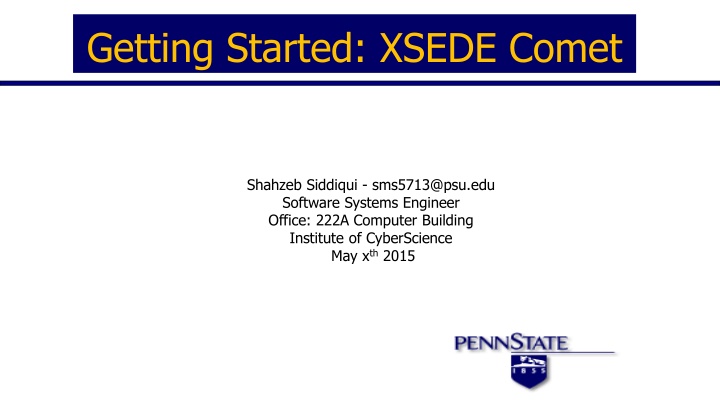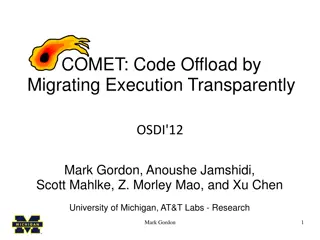
XSEDE Comet System Overview and Access Guide
"Learn about XSEDE Comet cluster, its specifications, software environment, accessing requirements, environment modules, and account management. Get insights into the high-performance computing system's features and how to utilize it effectively for research and projects."
Download Presentation

Please find below an Image/Link to download the presentation.
The content on the website is provided AS IS for your information and personal use only. It may not be sold, licensed, or shared on other websites without obtaining consent from the author. If you encounter any issues during the download, it is possible that the publisher has removed the file from their server.
You are allowed to download the files provided on this website for personal or commercial use, subject to the condition that they are used lawfully. All files are the property of their respective owners.
The content on the website is provided AS IS for your information and personal use only. It may not be sold, licensed, or shared on other websites without obtaining consent from the author.
E N D
Presentation Transcript
Getting Started: XSEDE Comet Shahzeb Siddiqui - sms5713@psu.edu Software Systems Engineer Office: 222A Computer Building Institute of CyberScience May xth 2015
System Overview Comet is one of the XSEDE cluster designed by Dell and SDSC that delivers 2.0 PFLOPS of performance. The system was available on XSEDE early 2015 Features include: next gen processor with AVX2, Mellanox FDR InfiniBand interconnect, and Aeon storage San Diego Supercomputer Center (SDSC) at University of California was awarded $12 million grant from NSF to build a petascale supercomputer Comet 2
Software Environment OS: CentOS Cluster Management: Rocks File System: NFS, Lustre Scheduler: SLURM User Environment: Modules Compilers: Intel, PGI Fortran/C/C++ MPI: Intel MPI, MVAPICH, OpenMPI Debugger: DDT Performance IPM, mpiP, PAPI, TAU 4
Accessing Comet Requirement: XSEDE account Submit proposal through XSEDE Allocation Request System Hostname: comet.sdsc.xsede.org Comet supports Single Sign On (SSO) through XSEDE User portal XSEDE SSO is a single point of entry to all XSEDE systems To login to XSEDE portal ssh <xsede-id>@login.xsede.org To access comet from XSEDE portal gsissh p 2222 comet.sdsc.xsede.org There are four login nodes when you access Comet: comet-ln[1-4].sdsc.edu 5
Environment Module Environment Module provides a method for dynamically changing the shell environment to use different software Few default modules are loaded at login including MVAPICH implementation of MPI and Intel compiler Its recommended to use MVAPICH and Intel Compiler for running MPI-based application to achieve the best performance 6
Account Management & Charging All jobs run on XSEDE system must be charged to a project. To view a list of authorized projects you have access to use the show_accounts command Charging: The charge unit measure for XSEDE systems is SU (Service Unit) which corresponds to one compute core for one hour. A job that requires 24 cores for 1 hour versus 1 core for 24hours will be charged the same 24 SU 8
Compiling with Intel, GCC, and PGI Intel PGI GCC 9
Running jobs on Comet Comet uses the Simple Linux Utility for Resource Management (SLURM) batch environment for running job in batch mode. sbatch <jobscript>: Submit Job squeue u user1: view all jobs by user1 scancel <jobid>: Cancel a job Comet has three queues to run your job: 10
Sample Job Script for MPI and OpenMP OpenMP Job-script MPI Job-script #!/bin/bash #SBATCH --job-name="hellompi" #SBATCH --output="hellompi.%j.%N.out" #SBATCH --partition=compute #SBATCH --nodes=2 #SBATCH --ntasks-per-node=24 #SBATCH --export=ALL #SBATCH -t 01:30:00 #!/bin/bash #SBATCH --job-name="hell_openmp" #SBATCH --output="hello_openmp.%j.%N.out" #SBATCH --partition=compute #SBATCH --nodes=1 #SBATCH --ntasks-per-node=24 #SBATCH --export=ALL #SBATCH -t 01:30:00 #This job runs with 2 nodes, 24 cores per node for a total of 48 cores. #SET the number of openmp threads export OMP_NUM_THREADS=24 #ibrun in verbose mode will give binding detail ibrun -v ../hello_mpi #Run the job using mpirun_rsh ./hello_openmp 11
Storage Overview on Comet SSD: 250GB of SSD per compute node that can be accessible during job execution in the directory local to each compute node: /scratch/$USER/$SLURM_JOB_ID /oasis/scratch/comet/$USER/temp_project Parallel Lustre Filesystem: 7PB of 200GB/sec performance storage and 6PB of 100GB/sec durable storage /oasis/projects 12
References http://www.sdsc.edu/support/user_guides/comet.html https://portal.xsede.org/single-sign-on-hub https://portal.xsede.org/sdsc-comet https://www.sdsc.edu/News%20Items/PR100313_comet.html 13










